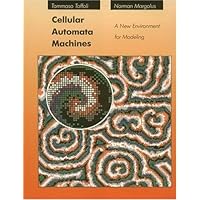
Average Reviews:

(More customer reviews)This is a terrific book that takes a step-by-step approach to cellular automata, especially for modelling. Within the first two chapters I had already found several interesting ideas for improving my own general-purpose automata program.
The part of the book that is most dated is the discussion of a specific hardware card and software designed for IBM PCs and ATs, and a specific dialect of Forth that can be used to program automata that will run on this card. Obviously this is no longer the mainstream approach to programming automata - even massively parallel systems programming has moved away from Forth. For me, I think of it as pseudo-code instead of a program example, and the book is still very very useful.
So on the whole, I would say this is a valuable addition to the bookshelf of any automata enthusiast.
Click Here to see more reviews about: Cellular Automata Machines: A New Environment for Modeling (Scientific Computation)
Recently, cellular automata machines with the size, speed, andflexibility for general experimentation at a moderate cost have become available tothe scientific community. These machines provide a laboratory in which the ideaspresented in this book can be tested and applied to the synthesis of a great varietyof systems. Computer scientists and researchers interested in modeling andsimulation as well as other scientists who do mathematical modeling will find thisintroduction to cellular automata and cellular automata machines (CAM) both usefuland timely.Cellular automata are the computer scientist's counterpart to thephysicist's concept of 'field' They provide natural models for many investigationsin physics, combinatorial mathematics, and computer science that deal with systemsextended in space and evolving in time according to local laws. A cellular automatamachine is a computer optimized for the simulation of cellular automata. Itsdedicated architecture allows it to run thousands of times faster than ageneral-purpose computer of comparable cost programmed to do the same task. Inpractical terms this permits intensive interactive experimentation and opens up newfields of research in distributed dynamics, including practical applicationsinvolving parallel computation and image processing.Contents: Introduction. CellularAutomata. The CAM Environment. A Live Demo. The Rules of the Game. Our First rules.Second-order Dynamics. The Laboratory. Neighbors and Neighborhood. Running. ParticleMotion. The Margolus Neighborhood. Noisy Neighbors. Display and Analysis. PhysicalModeling. Reversibility. Computing Machinery. Hydrodynamics. Statistical Mechanics.Other Applications. Imaging Processing. Rotations. Pattern Recognition. MultipleCAMS. Perspectives and Conclusions.Tommaso Toffoli and Norman Margolus areresearchers at the Laboratory for Computer Science at MIT. Cellular AutomataMachines is included in the Scientific Computation Series, edited by DennisCannon.

No comments:
Post a Comment